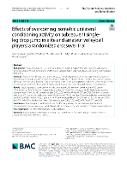Effects of overcoming isometric unilateral conditioning activity on subsequent single-leg drop jump in elite and amateur volleyball players: a randomized crossover trial

Autor
Terbalyan, Artur
Mikolajec, Kazimierz
Datum vydání
2025Publikováno v
BMC Sports Science, Medicine and RehabilitationRočník / Číslo vydání
17 (1)ISBN / ISSN
ISSN: 2052-1847ISBN / ISSN
eISSN: 2052-1847Metadata
Zobrazit celý záznamKolekce
Tato publikace má vydavatelskou verzi s DOI 10.1186/s13102-025-01083-9
Abstrakt
Background The study aimed to assess the acute effects of overcoming isometric split squats on subsequent single-leg drop jump (DJ) performance and the contralateral effect in volleyball players, considering training status differences. Methods Ten male elite (ELI) and ten amateur (AMA) volleyball players took part in two experimental sessions in which they performed conditioning activity (CA) consisted of 3 sets of overcoming isometric 3-second split squats, differing in the limb used: dominant (DL) or non-dominant (ND-L). Single-leg DJ was performed before and at the 4th and 8th minute post-CA for both limbs. The best post-CA attempt in terms of jump height (JH) was analyzed. Results Results revealed a significant increase in jump height (JH) in the non-dominant limb (ND-L) from 13.7 +/- 2.6 cm to 15.5 +/- 2.7 cm after CA performed by the ND-L (p = 0.001; Hedge's g = 0.65). Similarly, the reactive strength index (RSI) of the ND-L improved from 0.40 +/- 0.06 to 0.45 +/- 0.08 (p = 0.008; g = 0.58). Additionally, contact time in the ND-L increased significantly from 342 +/- 36 ms to 375 +/- 42 ms after CA performed by the dominant limb (p = 0.001; g = 0.66). In the elite (ELI) group, JH significantly increased from 16.4 +/- 2.4 cm to 18.3 +/- 3.3 cm (p < 0.001; g = 0.79), while RSI in the dominant limb (DL) improved from 0.47 +/- 0.06 to 0.53 +/- 0.07 (p = 0.011; g = 0.68). Conclusions Results suggest that the examined CA effectively induces the post-activation performance enhancement in DJ among elite volleyball players, with a predominantly local impact on the limb executing the CA.
Klíčová slova
Post-activation potentiation, Neuromuscular performance, Explosive strength, Isometric exercise, Unilateral movement, Plyometric training,
Trvalý odkaz
https://hdl.handle.net/20.500.14178/3037Licence
Licence pro užití plného textu výsledku: Creative Commons Uveďte původ-Neužívejte dílo komerčně-Nezpracovávejte 4.0 International







